Understanding the Verizon iPhone 4 Announcement
by Anand Lal Shimpi on January 11, 2011 1:32 PM EST- Posted in
- Smartphones
- Apple
- iPhone 4
- Verizon
- Mobile
Earlier today Verizon did what has been rumored for a while now and announced a partnership with Apple beginning with the CDMA iPhone 4.
Device pricing remains unchanged from the AT&T iPhone 4. The 16GB model retails for $199.99 while the 32GB will set you back $299.99. There is no white version available.
Hardware specs, both internal and external, remain unchanged. Apple is also quoting the same battery life as the AT&T version of the iPhone 4, although battery life is very dependent on signal strength so it will vary depending on network coverage where you use the phone.
Verizon isn't talking about data plan pricing and specifics at this point, although I suspect we'll find that out closer to the February 10th release date. Existing Verizon customers will be able to pre-order online beginning February 3rd, while the floodgates will open for everyone else on the 10th. Verizon insists that it has prepared both its retail presence and network for the launch, what that means for availability and likelihood of you getting a device remains to be seen. The good news is the iPhone 4 is a mature device that shouldn't be production limited. The launch will mostly be a question of whether Apple/Verizon appropriately estimated the number of customers they'll have on day 1.
Gallery: The Verizon iPhone 4
Verizon will offer a personal hotspot option for its iPhone 4, a feature that isn't available on AT&T. Apple wouldn't say if there are other architectural changes required for it, There aren't any architectural changes to enable personal hotspot, it's just something that Verizon supports and AT&T doesn't. Verizon isn't talking about pricing for enabling personal hotspot but functionally it works very similarly to tethering on the AT&T iPhone. You enable personal hotspot which you can use over Bluetooth or USB. If you have WiFi enabled you can connect up to 5 devices via WiFi to the Verizon iPhone 4.
Receive Antenna Diversity - The New Strip
I've got some more detail on the difference in antenna design on this new iPhone. As you can see from the pictures below, the good ol' death grip still attenuates signal strength on Verizon. Held normally I was getting a reading of -65 dBm on the Verizon iPhone, but in full on death grip the signal strength dropped to -83 dBm. That's in line with what we've seen on AT&T.
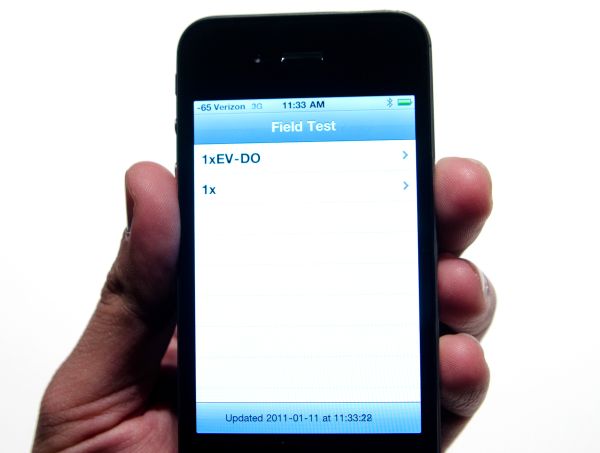
Verizon iPhone 4 - Held "properly"
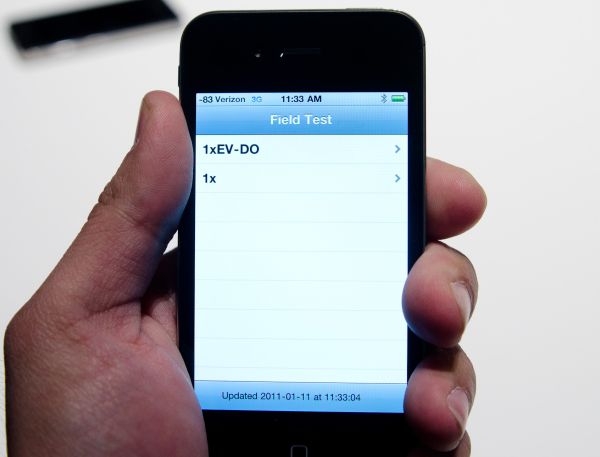
Verizon iPhone 4 - "Deathgrip"
You will notice that there are more external antenna segments on the Verizon iPhone compared to the AT&T model. Specifically, there's a new strip at the very top of the phone that previously was a part of the UMTS/GSM antenna. With the Verizon iPhone 4 that strip is actually for a secondary receive antenna. This dual-receive antenna architecture is something that Verizon refers to as antenna diversity and it's a part of Verizon's spec for devices on its network. This is not something that's present on the GSM version of the iPhone 4.
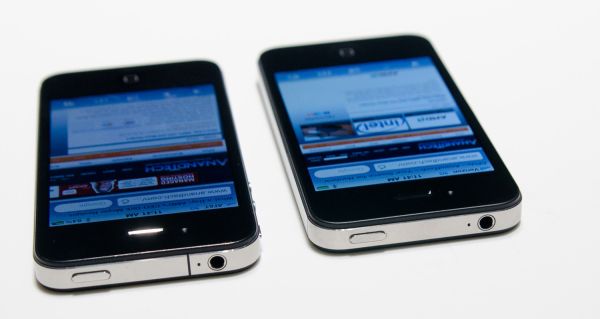
AT&T iPhone 4 (left) vs. Verizon iPhone 4 (right) - Note the new antenna segment on the top
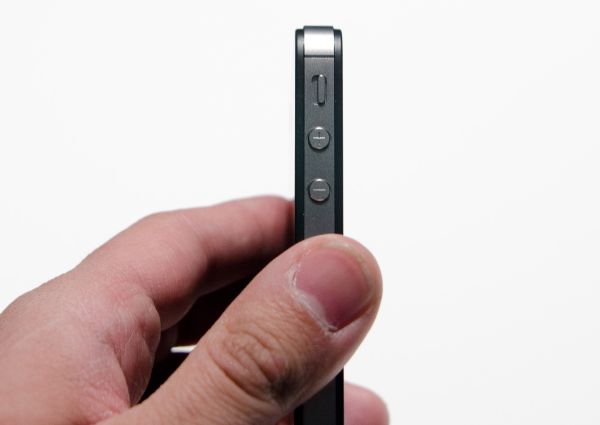
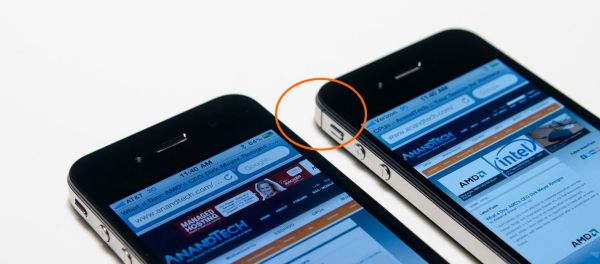
AT&T iPhone 4 (left) vs. Verizon iPhone 4 (right) - Note the new strip, that separates the secondary receive antenna
It's too early to tell if receive antenna diversity will mitigate the hand holding problems that drop calls in low signal scenarios. We will have to do extensive testing before we can figure that part out.
Network Performance
As far as network performance goes, AT&T's signal is strong but performance isn't very good at the Lincoln Center where Verizon held today's press event. To showcase network performance we have a couple of options. First up is a web page load test. I loaded three pages: AnandTech.com, our Dirk Meyer article and the CPU section on the site. The video below shows the latter two in action (AT&T on the left, Verizon on the right):
Again I have to mention that AT&T's performance at the Lincoln Center in NYC is pretty bad, definitely worse than it is at my office in Raleigh, NC. This is ultimately what will determine whether you go with the Verizon or AT&T versions of the iPhone 4 - what the network coverage looks like in your area.
Apple didn't have any installations of the Speedtest app, so we had to resort to using testmy.net. I ran three times on both the upload and download, I've reported the results below:
| Verizon iPhone 4 Network Performance at Lincoln Center in NYC | ||||
| Direction | Downstream | Upstream | ||
| Average | 1888 kbps | 321 kbps | ||
| Max/Min | 2238/1483 kbps | 368/256 kbps | ||
Download speed is suspiciously good. At 2.2Mbps it's higher than I have seen AT&T's iPhone 4 hit anywhere in NYC and the highest download speed I've ever seen for a device on Verizon that I've tested. Verizon likely has a local femtocell here to guarantee the best performance possible.
Upload speed is significantly worse however at only 321Kb/s on average. This is pretty typical for EVDO devices.
We'll have to wait until we get devices in hand before we can truly characterize network performance on the new Verizon iPhone 4. The numbers above are only a small snapshot of behavior.
As I mentioned in our earlier coverage, you can't use data and voice at the same time on the Verizon iPhone 4 (unless the data is over WiFi). If you are in the middle of a call and try to load a web page you'll get an error telling you that data is not available.
You'll notice that the 3G marker goes away during a call as well (because the call doesn't technically use the 3G radio). It doesn't disappear when you're sending an SMS however.
And there you have it. We'll be publishing a full review as soon as we can get our hands on a sample.


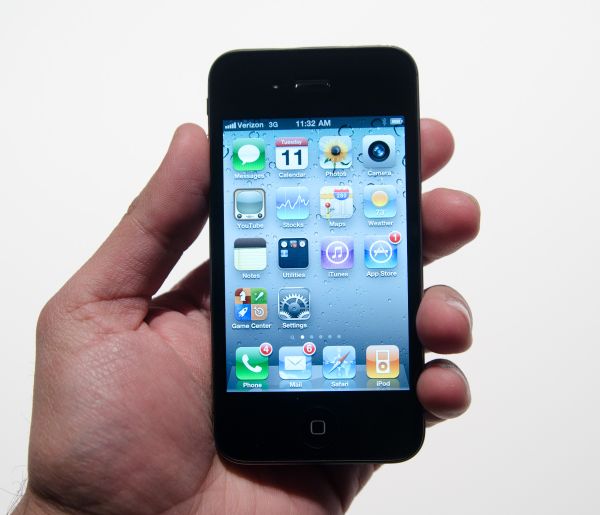






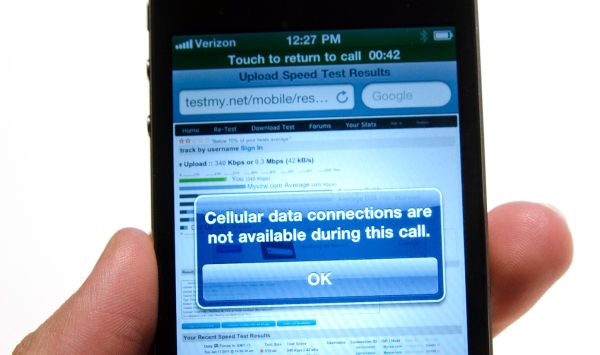








63 Comments
View All Comments
vol7ron - Tuesday, January 11, 2011 - link
While I don't disagree with your comment, Microsoft isn't in hardware b/c it's a software company (Microsoft[ware]). It started with software - that's what it does.You've mentioned a problem I've indicated as the app store was introduced: financial tethering. The more the customer invests in the apps and software, the less likely he/she might jump ship. That's actually one of the reasons I might go to an Android phone - there are so many phones that support it (many different hardwares) and I'm assuming you can move your apps from one to the other. Apple makes one phone (in different versions) and the only thing you may be able to transfer between is the iPod Touch/iPad.
The other reason is still: no flash support. Jobs may have announced they will never support it, which might have been ok, but it's his reasoning behind it that didn't make sense; it seems like he has a vendetta. I'm tired of seeing little icons where text/images should be and I don't want to use QuickTime for a media browser - I want more options.
Sabresiberian - Tuesday, January 11, 2011 - link
How you NOT recommend one is refusing to buy into a closed system.Why I don't buy Apple products is very simple - they want to control everything you buy with their products. I'll never buy an iPhone just for that reason alone. I don't buy game consoles for the same reason, or a host of other things. In some areas of life it can't be helped, but where it can, I try not to get locked in to one company supplying all my needs for something.
People want their OS to do everything for them - I don't. The more the OS does, the more I'm locked in to what the company that makes it provides. The same is coming down the line for video quality in computers - will Intel govern what we see in our computers in a decade? It could be that the only thing that prevents it is anti-trust laws, such as they are.
Here's another thing - eventually, the iPhone will fall behind in technology and never catch up, the way Apple always does. It's already falling behind. Eventually, you'll be stuck in an outdated, proprietary system. Yes, the iPhone created a cell phone beyond anything that existed at the time it was released - but you are a fool if you think it would never have happened without Apple. Yes, the iPhone is very cool - but it is also buggy and has been problematic since day 1, and it is already showing it's age. What will keep it going is the same thing that keep the iPod going - good marketing, locked-in marketing, and customer inertia.
;)
BSMonitor - Wednesday, January 12, 2011 - link
If you like spending ALL your free time monkeying with your phone and its OS, have at it on your WIndows or Andoird phones..Personally, and most people agree, I want to turn it on and have it work..
Thats it
You are the minority.
ZoSo - Wednesday, January 12, 2011 - link
I turn my Android phones on and they work. And I've made them perform better and more to my liking in about 40 minutes of 'monkeying' time, because I can,, LOLYuniverse - Wednesday, January 12, 2011 - link
iPhone buggy? really?I've never had such problems.
Aikouka - Wednesday, January 12, 2011 - link
I agree, bah12, that as you start "investing" in your phone, you begin to realize that moving away from that platform means you'll have to spend more money to get the same functionality or simply go without it because it doesn't exist on the other platform.I ended up buying an iPhone 3GS back when my only choices were Windows Mobile and Blackberry. I already had an AT&T Tilt, so I didn't want to stick with the dying mobile OS, and the one thing I noticed is that it seemed iOS was literally the choice for developers. Even with Android now, I still see quite a few developers only slowly adopting it or seemingly not adopting it at all.
My brother recently purchased a Droid X and I think he was a little surprised at all the nifty applications (i.e. not fart apps) that I can get on my phone compared to his. I was actually planning on possibly switch to a dual-core Android phone when my two years is up this February, but I might wait until the summer to compare Apple's next offering to the latest crop of Android phones. I'm still certainly willing to switch, but the amount of applications I have for my phone right now is a relatively huge part of the "Pro-iOS" column.
I did flash my old AT&T Tilt with Android (Froyo), so I can at least play with it on there :).
cmdrdredd - Wednesday, January 12, 2011 - link
There is an Android marketplace too that doesn't come with the communistic Apple certification process.cmdrdredd - Wednesday, January 12, 2011 - link
slight edit to previous: Unless you're talking about iTunes. In that case I say ok...maybe.triadone - Wednesday, January 12, 2011 - link
"When software is the driving factor, how do you NOT recommend the iPhone."Correction, when software that is user friendly and largely bug-free, how do you NOT recommend the iPhone? Having used an Evo 4G and had friends (tech savvy ones at that) who attempted to migrate to droid from iPhone it has been a no-go. The common buzz-phrase, even with Gingerbread, has been "It's too much work." e.g., They, and I, don't want to troubleshoot the device when something flips out. It reminds me of working with various Linux builds. Great idea, but the execution can falter enough times that the typical consumer will be chased away from the product. The tech savvy friends go for the iPhone and just jailbreak it. They get all the features they want, wifi hotspots and all.
The only thing I could recommend for iOS is to potentially allow for categories of Apps, somewhat like WM7, but without the annoying traffic sign symbols. As Anand's review noted, the idea is solid and goes beyond the use of folders. I just don't care for MS's implementation of it. MS is trying to be too hip IMO instead of having an interface that's usable for the general public (read: not just for 16-24 year-olds).
anactoraaron - Wednesday, January 12, 2011 - link
Do you know how many people already think they have an iPhone 4G? HA!